Aspalathus amoena
Aspalathus amoena (R.Dahlgren) R.Dahlgren
Family: Fabaceae
Common names: Bree Cape gorse
Introduction
Aspalathus amoena is a beautiful but not very well-known fynbos shrub from the Western Cape of South Africa, with pale yellow flowers and fine green leaves, and it grows wild in dry, rocky soil. This species is restricted to a small number of fragmented groups and has lost nearly all of its habitat, which gives it a status of Critically Endangered. It needs urgent conservation efforts.
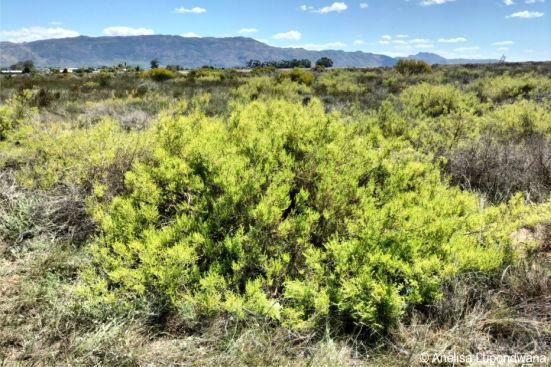
Description
Description
Aspalathus amoena is a small, upright shrub that grows between 300 and 700 mm tall with multiple, closely spaced branches, and the base of the plant reaches about 10 mm thick. It remains evergreen throughout the year. It grows slowly and can live a long time. The plant has woody branches at the base. Young stems are yellowish-green, either slightly hairy or sometimes smooth, while older stems turn light brown and feel slightly rough. The small flowering branches grow upwards and are thin, with one or two stalk-like segments up to 30 mm long. Its many slender stems give it a delicate, wiry look. The leaves are very small and grow in tight clusters of 3-9 leaflets. Each leaflet measures about 2 to 5 mm in length, with a narrow, slightly rounded shape. They are arranged alternately along the stems and feel smooth to the touch, giving the plant a delicate and fine-textured appearance.
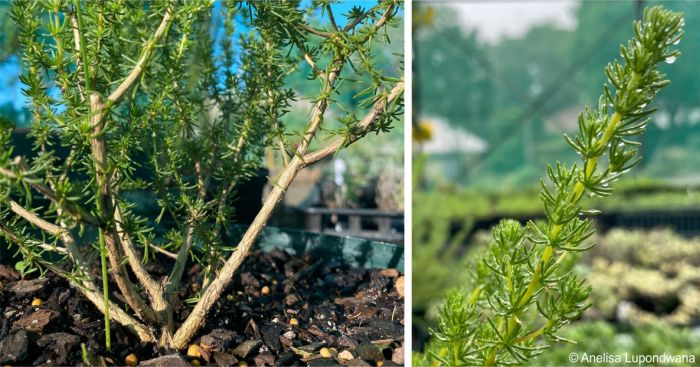
In spring (mainly from September to December), Aspalathus amoena produces clusters of small, pea-shaped flowers near the tips of the slender stalk-like branches. They have one or two green leaves near the base and small leaf-like bracts. These flowers are pale yellow, often becoming orange as they age. Each flower is about 10 mm across, and although individually small, they create a delicate and attractive display when in bloom. The main petal is oval, measuring about 6.5 to 8.5 mm long. Other petals are smaller, smooth, and have small fold-like lines. The pistil (female part) is slightly hairy on the upper parts of the ovary and near the base of the style, with two ovules and a rounded stigma. The flowers are supported by small, green, leaf-like structures called bracts. After flowering the plant produces small lance-shaped pods, about 11 to 14.5 mm long, that are brown and slightly hairy, containing one seed. This plant can be distinguished from relatives by its erect, bushy shape with slender, peduncle-like flowering branches bearing single pale-yellow flowers and small leaf clusters.
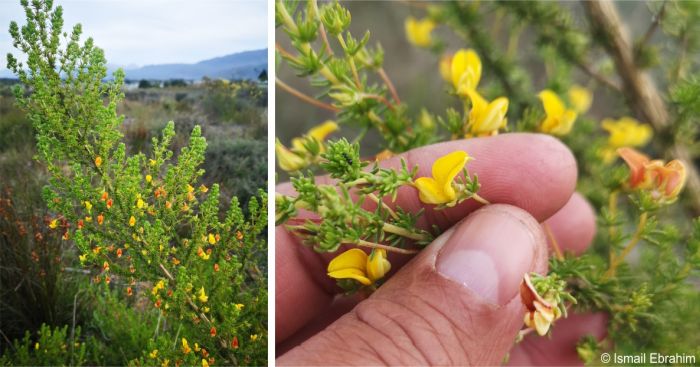
Conservation Status
Status
Aspalathus amoena is classified as Critically Endangered (CR) on the SANBI Red List of South African Plants because it has extremely limited known populations, with fewer than 10 mature individuals presently confirmed in three small subpopulations. This species was once thought to be extinct in 2009 but was rediscovered in very small numbers. The main threats to Aspalathus amoena include habitat loss from crop cultivation (citrus and vines) and invasive alien plants (in particular Acacia mearnsii) encroaching on their riverbank and sand flats habitat in the Breede River Valley, Western Cape.
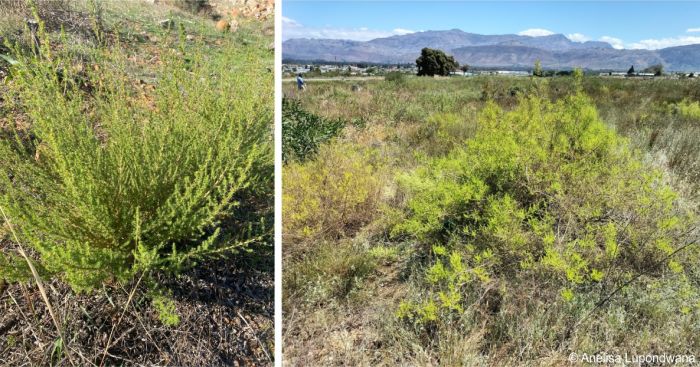
Distribution and habitat
Distribution description
Aspalathus amoena is naturally found on the plains of the Breede River Valley, in the area between Wolseley and Bree River Station in the Tulbagh and Worcester divisions of the Western Cape, South Africa. It grows in nutrient-poor, sandy soil that accumulates on riverbanks and adjacent flat sandy areas, growing associated with other sclerophyll scrub including A. quinquefolia subsp. virgata. The dominant vegetation type here is lowland fynbos, particularly the Breede Alluvium Fynbos, occurring at elevations between 300 and 1 000 m.
This species thrives in well-drained sandy soils typical of riverine flats and plains within a Mediterranean-type climate marked by wet winters and dry summers. Most rain, about 400 mm annually on the valley floor, falls in winter, between April and September. Higher mountainous areas of the valley receive much more rainfall, up to 2 300 mm. Summers are hot and dry, often reaching temperatures in the mid to high 30s Celsius. Winters are mild with occasional light frost, but snowfall is rare on the valley floor. The geology of the area consists of sandy alluvial deposits over Cape Supergroup rock formations, such as sandstones and shales.
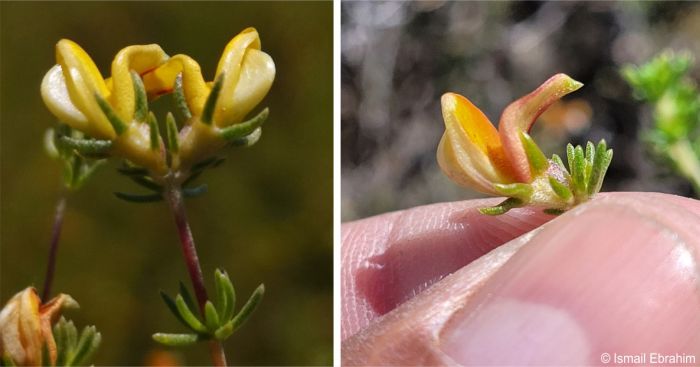
Derivation of name and historical aspects
History
The name Aspalathus appears in the Bible, but it likely did not refer to the same group of plants we now call Aspalathus. Instead, it probably described a species of Convolvulus or Alhagi. The first formal published account of Aspalathus species as we know them today was by the botanist Breyne in 1678. Later, the famous Swedish botanist Carl Linnaeus used the name in 1740 in his work Systema Naturae, and in 1753, he described 12 species of Aspalathus in his groundbreaking Species Plantarum. The name Aspalathus is derived from an ancient Greek word ἀσπάλαθος (aspalathos), which referred to a thorny shrub mentioned in classical texts. The species name amoena comes from Latin, meaning pleasant or delightful, likely describing the plant’s graceful appearance or attractive flowers. Aspalathus amoena was described formally by Swedish botanist Rolf Dahlgren in 1968. Dahlgren was a leading authority on the genus Aspalathus and made significant contributions to its taxonomy, describing many new species within this large and complex group endemic to South Africa.
Aspalathus amoena belongs to the genus Aspalathus, which is part of the large and economically significant family, Fabaceae, also known as the legume or pea family, the third largest family of flowering plants after Orchidaceae and Asteraceae, comprising approximately 770 genera and more than 19 000 species globally. Members of this family occur in a wide range of habitats and display diverse growth forms, including trees, shrubs, climbers, and herbaceous plants. The genus Aspalathus is taxonomically significant and highly diverse, with approximately 279 species, the vast majority of which are endemic to South Africa. This genus is almost entirely restricted to the Cape Floristic Region (CFR), where species are adapted to the nutrient-poor, acidic, sandy soils and fire-prone environment of the fynbos biome. Most Aspalathus species are woody, ericoid shrubs characterized by small, needle-like leaves and bright yellow flowers, which are adapted to attract insect pollinators. The genus is of considerable ecological importance in maintaining fynbos biodiversity and resilience. Economically, Aspalathus linearis, the source of rooibos tea, is the most prominent member, cultivated extensively in the Cederberg and surrounding areas. Beyond its commercial value, the genus has conservation importance, as many Aspalathus species are rare, localized endemics threatened by habitat loss, invasive alien plants, and climate change.
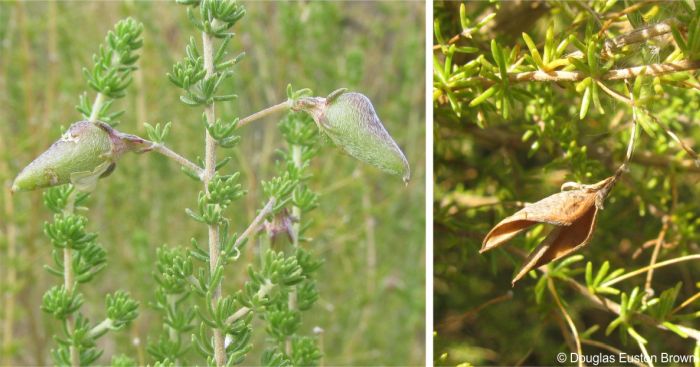
Ecology
Ecology
Aspalathus amoena produces pale yellow flowers that are likely pollinated by insects, especially bees, which are common pollinators of Fabaceae species. The flower structure with a standard petal, wings, and keel, is typical of legumes and adapted for buzz pollination, where bees vibrate the flower to release pollen. The bright colour and solitary arrangement on slender branches help attract pollinators visually.
The plant produces hard, lanceolate pods that dry and split open when mature. This allows seeds to be scattered near the parent plant. While there is no evidence of animal dispersal, the pod’s structure suggests gravity and wind may assist in short-distance dispersal.
Aspalathus amoena is adapted to the sandy soils along riverbanks in the Breede River Valley, which is prone to seasonal droughts and fire, as is typical of fynbos. Its subterete, glabrous leaves prevent water loss, allowing it to survive in dry environments. It is suspected to have the ability to resprout after fire, an important survival strategy in fire-prone habitats. Little is known about other ecological aspects of the species.
A key ecological trait of the Fabaceae family is its ability to establish symbiotic associations with nitrogen-fixing bacteria (Rhizobium spp. and related genera) housed within root nodules. This adaptation not only benefits the host plant by improving nitrogen availability but also enriches surrounding soils, enhancing ecosystem productivity and supporting agricultural sustainability. Furthermore, Fabaceae members provide critical ecosystem services such as erosion control, forage for wildlife and livestock, and resources for pollinators.
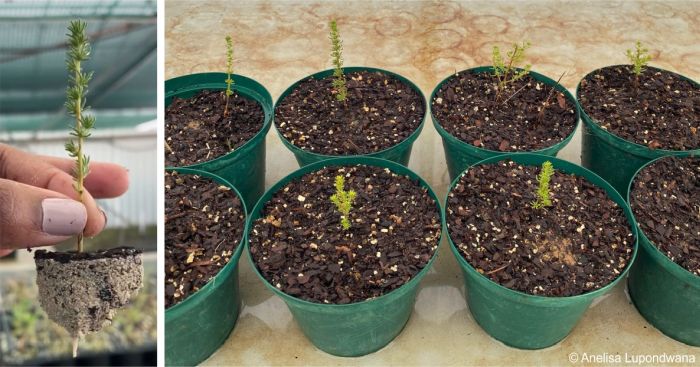
Uses
Use
Aspalathus amoena does not have documented traditional or economic uses, likely due to its rarity and critically endangered status, which limits its availability and use. However, the genus Aspalathus includes species of greater cultural and economic importance, most notably Aspalathus linearis, commonly known as rooibos. Rooibos is famous in South Africa as a caffeine-free herbal tea with high antioxidant content and has been traditionally used by indigenous communities, such as the San and Khoi, for medicinal purposes including soothing colic, allergies, and skin ailments. Rooibos cultivation has become a significant industry, with products ranging from tea to cosmetics and health supplements. Aspalathus species have never been developed as garden plants, even though many appealing species hold significant potential. Rooibos tea, derived from Aspalathus linearis, is the only species in the genus with significant economic and cultural value.
Growing Aspalathus amoena
Grow
Aspalathus amoena can be grown from both seeds and cuttings, but both methods present challenges due to hard seed coats and poor rooting. Seed germination is often very low, so seeds must be pretreated to improve the chances of germination. Seeds can be collected from May before pods split open and are usually sown in March and later transplanted into acidic, sandy soils. Soak the seeds in concentrated sulfuric acid for a short time, soak them in water for 24 hours, or rub them with sandpaper to thin the coat and encourages better germination. Once treated, sow the seeds in a well-draining mix of bark, river sand, and peat moss.
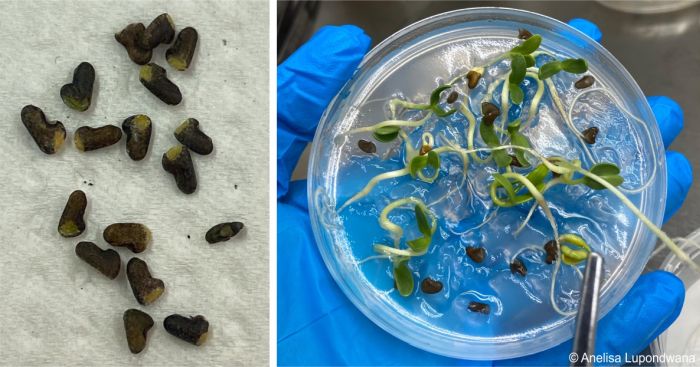
The plant can also be propagated by cuttings. Cuttings can be made in early spring or autumn (September to March). It is best to use material from young plants as they root more easily than older plants. Use tip or heel cuttings from healthy plants, dip them in a rooting hormone containing IBA and NAA, and plant them in a propagation medium such as milled bark, sand, and peat moss. Place the cuttings under high humidity with intermittent misting every 30 minutes for 20 seconds in a house with temperatures between 12°C and 26°C, on benches with bottom heat around 30–33°C to encourage rooting. Cuttings usually root within four to six weeks.
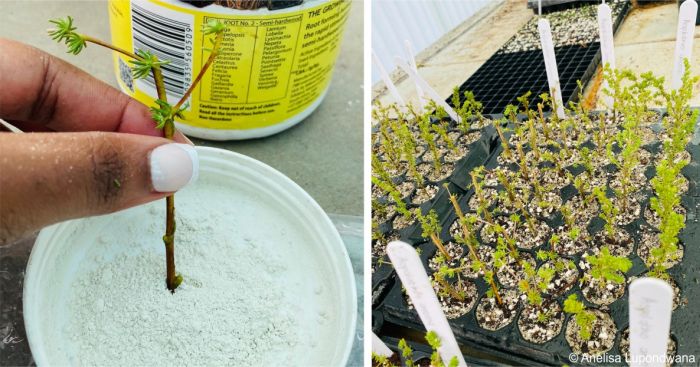
For cultivation, grow Aspalathus amoena in full sun or light shade. The soil should be sandy or loamy, well-draining, and acidic, similar to its natural fynbos environment. Avoid heavy clay or waterlogged soil, as the roots are sensitive to too much moisture. Water the plant moderately, allowing the soil to dry a little between waterings. In cooler months, reduce watering. It grows slowly and benefits from light pruning after flowering to maintain its shape and encourage bushier growth. Do not over-fertilize, but you can use a small amount of organic compost, slow-release fertilizer or a low-phosphorus fertilizer if needed.
Use it as a feature or filler shrub in fynbos-style gardens, where it pairs well with other drought-tolerant South African plants that prefer similar soil and sun conditions. Avoid planting it in heavy clay or waterlogged soil. Aspalathus amoena works well as an elegant shrub with fine needle-like leaves and pale-yellow pea flowers. It suits containers, mixed native borders, or can be a focal point in small garden beds. This detailed propagation and cultivation guidance is based on ongoing research and practical trials at Kirstenbosch National Botanical Garden.
References
- Cupido, C. 2005. Aspalathus L. (Fabaceae). PlantZAfrica. Online. https://pza.sanbi.org/aspalathus.
- Dahlgren, R. 1988. Crotalarieae (Aspalathus). Flora of Southern Africa 16(3):1-423.
- Ebrahim, I. 2025. Observations of Aspalathus amoena. iNaturalist. Online. https://www.inaturalist.org/observations?taxon_id=580404&user_id=ish_crew.
- Euston-Brown, D. 2025. Observations of Aspalathus amoena. iNaturalist. Online. https://www.inaturalist.org/observations?taxon_id=580404&user_id=douglaseustonbrown.
- Manning, J. & Goldblatt, P. 2012. Plants of the Greater Cape Floristic Region 1: the Core Cape Flora. Strelitzia 29. South African National Biodiversity Institute, Pretoria.
- Schutte-Vlok, A.L., Raimondo, D. & van der Colff, D. 2015. Aspalathus amoena (R. Dahlgren) R. Dahlgren. National Assessment: Red List of South African Plants version. https://redlist.sanbi.org/species.php?species=364-32.
- Velazquez, E., R Silva, L. & Peix, A. 2010. Legumes: a healthy and ecological source of flavonoids. Current Nutrition & Food Science 6(2):109-144.
- WFO, The World Flora Online. Aspalathus amoena (R.Dahlgren) R.Dahlgren.http://www.worldfloraonline.org/taxon/wfo-0001033903. Accessed 10 Sep 2025.
Credits
Anelisa Lupondwana
Kirstenbosch National Botanical Garden
October 2025
Acknowledgements: the author gives special thanks to her supervisor Mr. Ntuthuko Mabuya for his valuable input and support in preparing this article, and thanks Ismail Ebrahim and Douglas Euston-Brown for sharing their images of the flowers and fruits via iNaturalist.
Plant Attributes:
Plant Type: Shrub
SA Distribution: Western Cape
Soil type: Sandy
Flowering season: Spring, Early Summer
PH: Acid
Flower colour: Yellow, Orange
Aspect: Full Sun
Gardening skill: Challenging
Special Features:
Horticultural zones







Rate this article
Article well written and informative
Rate this plant
Is this an interesting plant?
Login to add your Comment
Back to topNot registered yet? Click here to register.